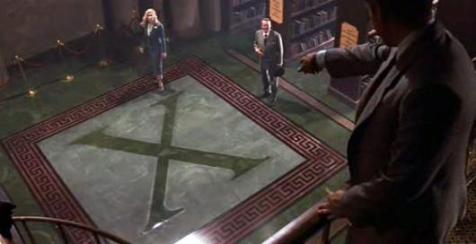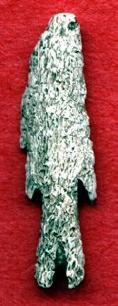I love the Indiana Jones movies, they are a lot of fun and I really like Harrison Ford as an actor but I have to say, he has ruined the public perception of what archaeology really is about. For example, I do not own a felt Fedora, a bullwhip or a pistol. However, I do own an excellent Tilley hat, a nice Marshalltown trowel and I can count on one hand how many times I’ve been in a fistfight; none of those fights were with other archaeologists or Nazis. Archaeologists do not follow maps to buried treasure (It is an artifact, not treasure!), we would not search an entire site for just one artifact, and X never marks the spot.

As an example of just how wrong Indiana has portrayed archaeology lets just look at survey work. So if X never marks the spot, how do we actually find archaeology sites? Very often members of the public tell us about artifacts they have found. This has led to the discovery of sites such as the Norse occupation at L’Anse aux Meadows and the Maritime Archaic cemetery at Port au Choix (In nearly 20 years of doing archaeology I have never been told about gold artifacts – sorry Indiana). Many archaeology sites are found as part of an archaeology survey that comes in two main forms; a survey geared toward finding sites of a particular culture or a survey to find any archaeological sites. The two are not mutually exclusive; even on a survey searching for a particular culture, all the sites that are found are recorded. Surveys are usually undertaken in areas where archaeological work has not been done before. I am pretty sure Indiana Jones would never take part in an archaeology survey unless he knew a site existed in the area.


Usually, surveys that are geared toward finding sites of a particular culture are often run by academics with specific research questions. For example, I worked on a project where the director was mainly interested in finding precontact aboriginal sites on the Baie Verte Peninsula; in particular, he was mostly interested in Dorset Pre-Inuit sites. During the survey, we made sure to search places where Dorset sites are typically found such as outer exposed coastal areas because the Dorset were a marine-oriented people. Luckily enough we did find some Pre-Inuit material, but we also found several sites from other cultures such as Recent Period and European. We ended up excavating a nice Recent Period site that summer, despite the fact that the focus of the work was on Pre-Inuit material.


I’ve discussed another survey that was geared toward finding sites of a particular culture in my previous post on the Newfoundland Mi’kmaq. That survey was geared toward looking for Mi’kmaq sites; unfortunately, it was not as successful from a Mi’kmaq perspective as was the survey I participated in looking for Dorset sites. However, the Mi’kmaq survey did result in the discovery of 18 new archaeology sites.
The second type of survey work, when the goal is to find all archaeological sites, is often undertaken in areas where little archaeological work had previously occurred or in an area that is slated for development and has to be archaeologically assessed. I have also participated in this type of survey. In 1997, I helped to survey the area around the community of Bird Cove on the Northern Peninsula. The area had never been assessed archaeologically and we ended up finding 15 sites that year which contained everything from 4500-year-old Maritime Archaic material to recent European material.


In terms of archaeology surveys prior to development, an example in this province would be the huge multi-year archaeological survey undertaken in the area around Voisey’s Bay just before the mine and processing plant was slated to be built. In just the mine area, more than 50 sites were located. They included everything from Maritime Archaic and Intermediate Period to more recent Innu, Inuit, and European sites.
Regardless of the form of survey, prior to any ground disturbance, the archaeologist must apply to the appropriate permitting authority (Provincial Archaeology Office, Nunatsiavut archaeology Office or Parks Canada, depending upon where the survey is to occur) for an archaeology permit before survey work can occur. In the case of the Provincial Archaeology Office that authority comes from the Historic Resources Act. Each permit application is reviewed and if an application is found to be lacking information (which rarely happens), the correct permitting authority will notify the archaeologist of what needs to be corrected. All archaeological resources that are found during survey work are recorded and that information is passed on to the appropriate permitting authority. If the permitting authority is assured that historic resources will not be impacted, the project can proceed. Of course, this is a very simplistic explanation, but it is the bare bones of the process.
On the ground, regardless of the survey form, a team of archaeologists or people trained by archaeologists usually undertakes archaeology surveys. Depending on the area to be surveyed, the team may spread out in a line with a few metres between each member and they will dig a test pit with a shovel and trowel. Usually, the test pits are 30-50 centimetres square and the team member will be looking for artifacts or maybe soil changes that may indicate a buried occupation horizon. If nothing is found the team member will pick up his/her gear, move ahead a few metres depending on the archaeologist’s discretion, and dig another test pit. However, if the team member finds an artifact or a soil deposit that may relate to a site the archaeologist is notified and the team may dig extra test pits around the find spot in an effort to delineate the potential size of the site. The site may be comprised of just that single find in the test pit or the team could find themselves on the edge of a site that is thousands of metres square in size. All of this methodology is typical and is usually defined in the archaeologist’s permit application. Survey work can be slow, tedious and backbreaking if you find nothing; I somehow doubt Indiana would have enjoyed survey work.


This method also resulted in the discovery of North Cove, the Recent Period and Dorset Pre-Inuit site that I excavated as part of my Masters Thesis near Bird Cove. Unlike Indiana Jones, I didn’t have to shoot anyone or get into a fistfight with any Nazis to find the site and everything I found was properly recorded and documented.


As much fun as the movies were, as an archaeologist I have to ask, did Indiana Jones do anything to help archaeology? Yes, a little. The movies and character certainly popularized the discipline and made people realize the importance of properly displaying artifacts in a museum for everyone to see. Yet, he did so much else that makes archaeologists everywhere cringe. I can’t really see Indiana applying for a permit to do survey work, nor can I see him recording everything that he found. Indiana would not go through this process, he’d just shoot someone.

Although I agree with your rundown of modern archaeological practices and procedures, you have to realize that the times being portrayed are in the mid-1940s, and Hitler was in fact stealing as much human patrimony that he could. The type of archaeology that Indiana Jones was practicing is really Old World Archaeology; the type of archaeology that a Heinrich Schiemann , or Arthur Evans (as a couple examples) employed. Some think Schiemann was a treasure hunter too, and many of the Troy artifacts could be considered treasure. This type of archaeology was based on a study of classical literature (you get a sense of the passion and detail from Henry Jones’ journal (field book?). Even today there are Archaeologists that search out sites based on the literature such as “Bible Archaeology.”
Indiana Jones specifically told his class that “X never, never, marks the spot.” So he agrees that archaeology is not a treasure hunt. It just happened that the roman numeral for ten is in the form of an “X” so it was ironic and thus his verbal to himself that [well maybe] “X” sometimes does mark the spot. Of course we know that it did not mark the spot of the textual artifact they were looking for but the path to it (and yes what happened after the discovery of the shield was terrible from an archaeological perspective).
We get a clue during Jones classroom scene, that at some times he must be doing “real archaeology” as you describe it. But these are movies and as pointed out archaeological practices are just not that exciting in the sense of a movie script.
Indiana Jones is taught in University under the topic of “Popular Archaeology.” These differences in what you see in the movies and the scientific method are pointed out. Indiana Jones has indeed helped our field, and I will have to disagree with the statement “he has ruined the public perception of what archaeology really is about.”
Thank you very much for your points on my post. I agree with what you have written. However, I think you may have taken my criticism of Indiana Jones too seriously, or perhaps I was not clear enough in the post. My intention was to explain to the public the concept of an archaeological survey through a tounge-in-cheek look at Indiana Jones. Perhaps I went overboard with too much Indiana and too little survey?
Hey not a problem Stephen. The subject still makes for good commentary discussion. I did however miss the tongue-in-cheek aspect. The information you documented in your post is right on. I think it gives a good perspective on what we must go through to provide good scieince.
On the other side of it, I liked how you used Indiana Jones. After all it got me thinking about how our field got started when it was for the most part, rich individuals with a lot of time on thier hands to work on a problem they were interested in. I’d like actually like to hear what other’s think of those times and whether they think the research and science of the time is and was legitimate and advanced our knowledge. There are many out there that wish they could be an Archaeologist, and I am happy that Indiana Jones has brought our profession more into the light, such that there are more young people taking it up. Thanks for the clarification Stephen.
Good discussion indeed, I’ve had a lot of comments on this post, both on this blog forum and in other forums. Part of the reason for this blog and this post is public misunderstanding of archaeology. Archaeologists, myself included, need to do a better job of communicating what we do and how we do it.
I think the work done by many ‘early’ archaeologists was good science given the state of science & methodology at the time. However, if someone were to try to practice archaeology like that today they would not be well received at all.
Thanks for your comments.
“However, if someone were to try to practice archaeology like that today they would not be well received at all.”
As I mention in my earlier post I think it is practiced in similar ways today with some modification due to heritage laws around the world and a desire to maintain a state’s cultural patrimony in its origin country.
I think the difference is what kind of research you are undertaking. If you are doing “Classical Period” archaeology, you have the luxury of the written word, albeit some texts we still cannot read. In that field you start in libraries. This is how modern discoveries are made of sites that may look like a hill or natural mound today.
In the North American archaeology we don’t usually have that, so we must do land surveys and hope to discover a significant site to research. We also have the problem of perception about site types. For instance here in the US, I have worked across the country and little is known about the Archaic period because there are so many “lithic scatters,” that they are not generally determined eligible to the National Register, and they are not studied other than noting their location. So most states have research questions about the Archaic period on the books but because it isn’t sexy archaeology, not much is done.
Much of the historic period archaeology in this province benefits from historic documentation.
Again in Newfoundland and Labrador, we would certainly register sites that were lithic scatters, you can learn a lot from lithic scatters. It’s too bad more attention isn’t paid to them in you neck of the woods.
Still gotta like Indy. (My sister named her dog after him!) your points about modern process are well made, but yeah, one cannot see Indy applying for permits and waiting for permissions. Doesn’t make for exciting action sequences.
Absolutely, I still enjoy the movies. I took my kids to Disney a few years back and we saw a performance of some of the action sequences in the Indiana Jones movies; my kids loved it (I did too!). But people need to remember that what they see in movies is not necessarily what real life is like.
Thanks for the comment.